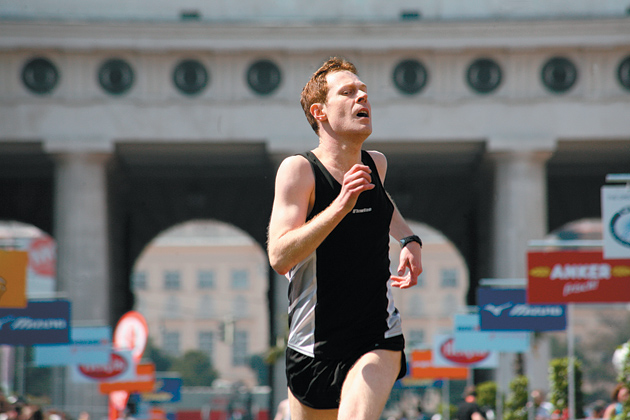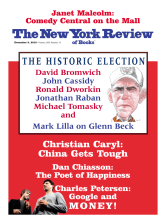There are many ways to train for the New York Marathon. My own method involved running three days a week and watching as many running movies as possible—and not just films about famous runners or historic races. (By far the best known of these, Chariots of Fire (1981), about the British heroes of the 1924 Olympics, is hard to watch: the races are shown in absurdly overdramatized slow motion, making one want to fast-forward through the entire thing.) Much more interesting are movies that in some way explore the psychology of running, even if they are mostly about other matters. In this vein, Benjamin Heisenberg’s remarkable new film Der Räuber (The Robber, 2010), about a serial bank robber, may be the most eloquent—and disturbing—portrait of the running mind ever made.
To understand the importance of Heisenberg’s film, it is worth first considering the surprisingly rich history of films that deal tangentially with running. At a time when marathoning was still largely the province of elite professionals and amateur obsessives, John Schlesinger’s paranoid thriller Marathon Man (1976) was prescient in suggesting that the sport might have broader relevance for coping with the multifarious challenges of the late-twentieth-century world. The plot is suitably over-the-top: the protagonist, played by Dustin Hoffman, is a driven Columbia graduate student who is writing a dissertation about the McCarthy witch hunts and training for his first marathon; he becomes enmeshed in a CIA plot involving an ex-Nazi doctor who wants him dead.
But the larger theme here seems to be escape, or just survival, and the most persuasive parts of the film show Hoffman’s character contending with the mean streets of New York. In a climactic scene, he is sprinting barefoot toward the entrance ramp of the Brooklyn Bridge, pursued by armed men. He is able to elude them by replaying in his head the Olympic triumphs of Abebe Bikila, the Ethiopian legend who won the 1960 marathon running shoeless through the streets of Rome. Marathon Man evokes Bikila’s poise through footage from Tokyo Olympiad (1965), in which the impossibly placid Ethiopian, this time wearing shoes, repeats his Olympic victory in Tokyo.
Although there is much talk now of Kenyan runners dominating the sport, the current marathon world record is once again held by an Ethiopian, Haile Gebrselassie, who also was a favorite in this year’s New York Marathon. (He set his record of two hours, three minutes, and fifty-nine seconds in Berlin in 2008, when he was thirty-five years old.) Like Bikila a half-century ago, Gebrselassie has an entrancing way of making the outer edge of human physical potential look rather effortless. Take the opening minutes of Endurance (1999), a film about Gebrselassie’s rise from poor Ethiopian farmer’s boy to Olympic gold medalist, in which he bounds across the rough rural highland where he grew up, mile after mile, with gazelle-like ease.
Since the outcome is clear, however, there is rarely much drama in sports-hero movies like Endurance and Chariots of Fire. Indeed, one of the more perceptive takes on running may be Majid Majidi’s Children of Heaven (1997), about the desperate efforts of a poor boy in Tehran to replace his sister’s lost shoes; it climaxes in a children’s road race in which the boy’s goal is to come in not first but third (the third-place prize includes a pair of shoes). A darker counterpoint to the footrace genre can be found as early as 1962, with The Loneliness of the Long Distance Runner. In this British film, a rebellious reform school boy excels at running but ultimately finds it preferable to lose the big race, in a great stroke of nihilism, than to have running determine the course of his rehabilitation.
It is with The Robber, however, that the runner as antihero comes into full view. In the opening scene Johann Rettenberger, the wiry protagonist (played with quiet intensity by Andreas Lust), is running laps incessantly around a small square yard. You hear his name being called. He finally stops and looks at his watch. Then he runs into the building at the edge of the yard, where he is head-counted. Then an iron gate is locked behind him and it dawns on you: he is a convict in a prison; he was called for line-up. The camera—always pursuing him in long single shots—follows him back to his tiny prison cell, which is filled with a treadmill and rows of worn-out sneakers. He gets on the treadmill and continues his workout.
Rettenberger is an unusually gifted runner. He’s also an accomplished criminal. The intertwining of these two talents forms the overriding focus of this almost claustrophobic ninety-seven-minute film, which in its study of one man’s extreme pathology also has something important to say about why we run. Loosely based on a true story, The Robber recounts the life of “Pump-gun Ronnie,” the postwar Austrian outlaw Johann Kastenberger, who during several years in the 1980s alternated between brazen bank heists (his moniker came from the Ronald Reagan mask he wore and the pump-action shotgun he carried) and spectacular performances in long-distance road races. As Heisenberg, the film’s director, pointed out at the New York Film Festival this fall, Kastenberger’s record time in the Bergmarathon, a notoriously difficult uphill race in the Austrian Alps, still stands today.
Advertisement
The problem in The Robber is, Rettenberger is too good. As the grimacing Andreas Lust conveys so well, his growing athletic prowess—he sets a new Austrian record in the Vienna Marathon shortly after his release from prison—is actually making it more difficult for him to obtain fulfillment. At the same time, his successful holdups of branch banks have become too easy. He’s not interested in the cash, which he stuffs into a bag under his bed. Only by provoking the police into chasing him, and thereby requiring a headlong escape, does he attain a kind of fleeting nirvana—the runner’s high. (In a scene runners will appreciate, he is shown downloading his heart-rate data from the heart monitor he wore during one particularly difficult getaway.)
Perhaps inevitably, it will end badly, but not before Rettenberger stages a terrifying escape from police custody that begins the race of his life—a multi-day chase in freezing weather, much of it on foot, that soon turns into the largest manhunt in Austrian history. We never get very close to solving the mystery of Rettenberger; Heisenberg’s pared-down film wisely leaves his inner life opaque. And yet his animal drive and his overpowering urge to test his stamina in increasingly difficult situations get close to the mysterious attraction of long-distance running. Thankfully, few of us need to rob a bank to create that situation; 26.2 miles is more than enough.
On a crisp early November morning, I and 45,000 others ran through the five boroughs, from the suspended heights of the Verrazano Bridge to the hills of Central Park. The police were out in force, but none were giving chase; all of New York was watching. Still, the outcome was in doubt. Gebrselassie, the aging legend, dropped out at Mile 16, declaring his running days over; in his place emerged another Ethiopian, a twenty-six-year-old named Gebre Gebremariam, who won in his first attempt. As for my own debut, it nearly ended at Mile 24. But remembering Hoffman and Bikila and the steely Rettenberger, I strode on and on to the finish at Tavern on the Green, and all was well.
This Issue
December 9, 2010




